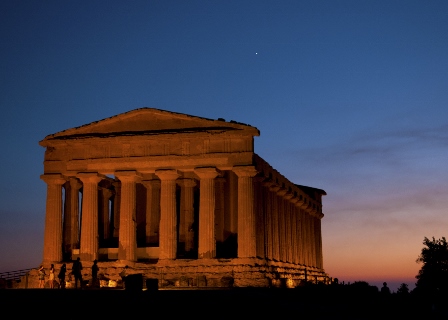
 italia.it
italia.it
Italian culture and history: Agrigento, The Sicilian Valley of the Temples
- WTI Magazine #82 Aug 19, 2016
-

 italia.it
italia.it
WTI Magazine #82 2016 August 19
Author : italia.it Translation by:
An exceptional historic testimony to Magna Graecia's presence in this area, as well as to subsequent epochs, the archaeological site at Agrigento, in Sicily, was inserted onto the UNESCO World Heritage List in 1997. The remains from the Hellenic city, and additionally from the successive Punic-Roman era, the imposing Doric temples – to this day almost completely intact – the agora, the pagan and Christian necropolises, and the crawling network of subterranean acqueducts, constitute the richness of this site. Extending over approximately 1,300 hectares, it recounts a millenary history that began in the 6th Century B.C. with the foundation of the ancient Greek colony of Akragas.
Standing on terraced levels at the top of a plateau, with a city plan resembling a chessboard, Akragas was one of the largest Greek cities on the Mediterranean Sea. Eventually enclosed with a defensive wall (featuring 9 entrances) in the 6th Century B.C., the colony saw a period of heavy expansion throughout the 5th Century B.C., during the reign of the tyrant Theron. This expansion continued when democracy was established: Doric temples were erected on the southern hill – a natural border of the southern edge of the plateau (and thus, the city). This was also the battle theatre during the fight between the Romans and Carthaginians over control of the Mediterranean. Later, the city fell into decay and disrepair until finally, the Romans conquered it, dubbing it "Agrigentum."
The actual core of the archaeological site of Agrigento lies in the area of the magnificent temples. The Temple to Zeus – or Jove the Olympian – and the only remaining ruins of which are its base and principal altar, was one of the biggest Greek temples in Antiquity. The oldest temple in Agrigento is, rather, that of Heracles or Hercules, while the best-preserved is that of the Concordia, probably the most impressive Greek Doric temple still extant in our day, after Athens's Parthenon. The structure was adapted as a Christian church, evidence of which can be seen in the tombs excavated in the ground.
The Temple to Hera Lacinia (or Juno) was built contemporarily to the Concordia, and it was severely damaged by a fire towards the end of the 5th Century B.C. Also worth seeing nearby are the Temple of Castor and Pollux (the Dioscuri); the Sanctuary dedicated to the goddesses of grain and vegetation (aka the Chtonic divinities) – Demeter and Persephone – who were worshipped with much devotion by the women in these parts; the Temple of Hephaestus or Vulcan, which faces the former temple across a pool that is fed by an aqueduct; the Temple of Isis, from the late Augustan-Tiberian period; the temple dedicated to Demetra alone and connected to the Rupe Atenea, the highest point of the city (that is, the ancient acropolis); the Sanctuary of Asclepius - the Greek god of medicine - a center for therapeutic rites; and, finally, the Temple to Athena, today part of the Church of Santa Maria dei Greci.
The site certainly does not lack for beautiful works and landscapes: among others to be seen are the ancient Greco-Roman agora, center of public life that was edified onto the area's terraces; the council room or Bouleuterion, in the northern section of Poggetto di San Nicola; and the Gymnasium, ancient location for athletic, educational and recreational activities.
The Valley of the Temples counts a zone rich in Greek, Roman, and Paleo-Christian necropolises not far outside the ancient city; and the Tomb of Theron, so-called due to an error in attribution - the tomb actually has nothing to do with the tyrant of Akragas. Last but not least, the remarkably-laborious aqueducts also go mentioned, as do the mosaic floors that have survived in areas such as the Hellenic and Roman residential zones (here, Villa Athena stands out) and in the Paleo-Christian Basilicas from later periods.